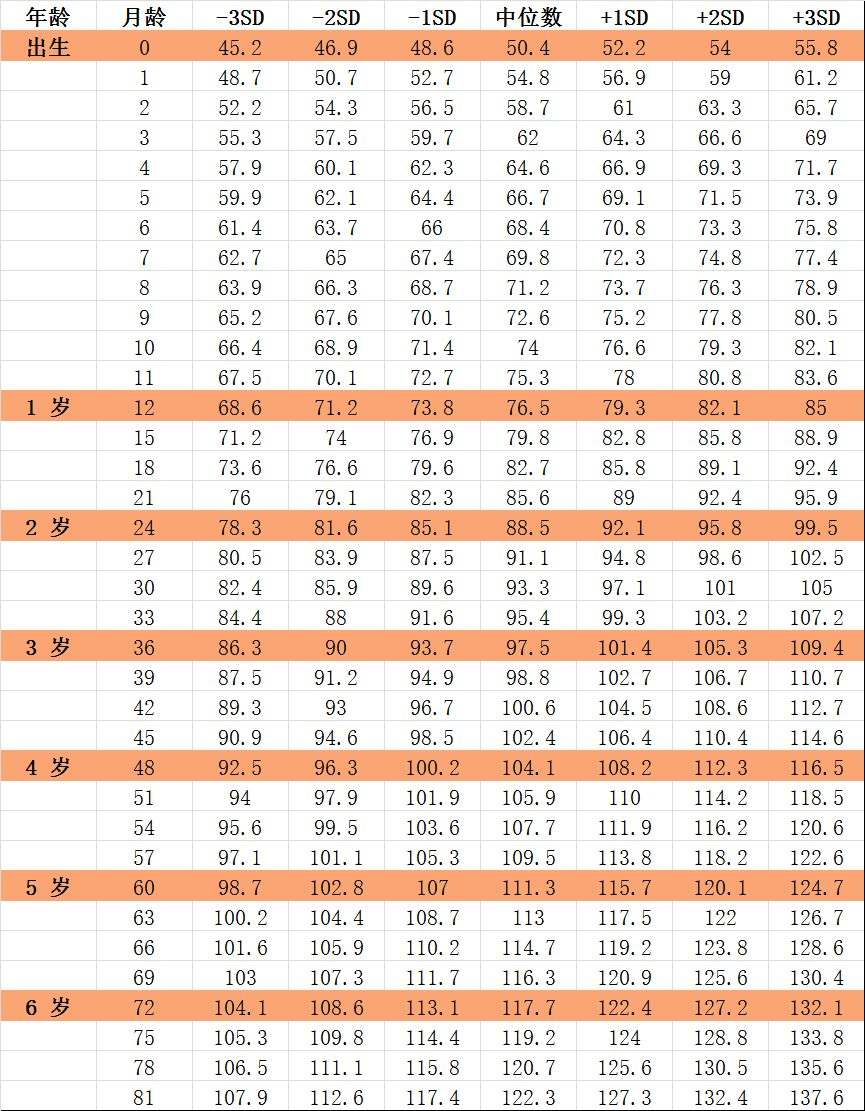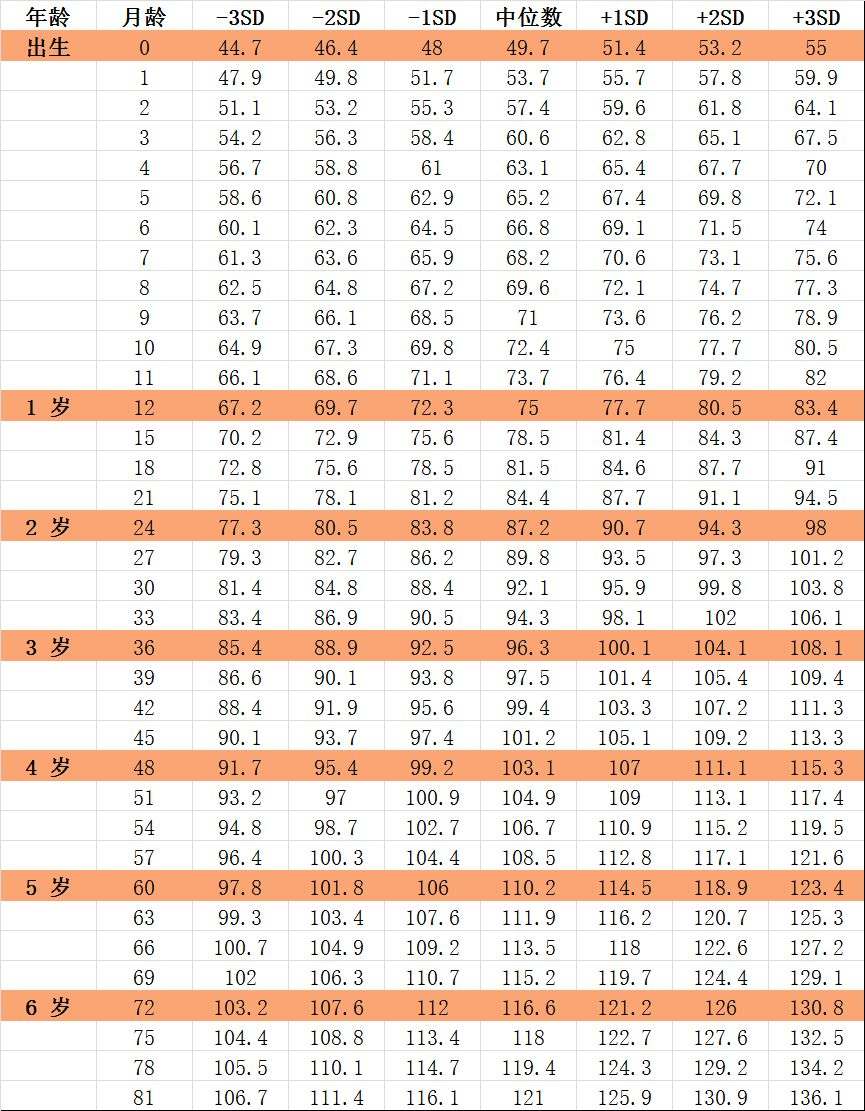Although the baby is [there is no worry about growth when there are seedlings], parents, without exception, all hope that the child’s height can be more advantageous.
Looking at my baby every day, I always feel that there is no big change. Compared with other people’s children, I feel that my baby grows slowly and short.
Today, we invited a licensed doctor to tell you how much the child’s height is up to standard, and to introduce ways to make the baby’s size jump up again.
How tall is the child normal?
Many parents think that their babies are growing slowly. In fact, in most cases, they are subjective guesses. The development trend of each baby is different.
However, to know whether the baby’s height is up to standard, parents can refer to the following < < China’s Reference Standard for Growth and Development of Children under 7 Years Old > > formulated by the Ministry of Health (click on the picture to enlarge and save it).
Height (length) standard value (cm) for boys under 7 years old

Height (length) standard value (CM) for girls under 7 years old

What do you think?
First find the baby’s age in the first and second columns on the left, and then look horizontally at which interval the baby’s height is in.
[Age] is followed by the percentile. As long as the baby’s height is between-2SD and + 2SD, it is normal.
If the height is less than-2SD, it means that the baby grows too slowly, which may be short stature. If the height is greater than + 2SD, the baby is growing a little faster.
For example:
The height of the 6-month-old male baby is 67cm, indicating that he is between the median and + 1SD, which is the normal range.
Do you want to see a doctor under what’s condition?

The normal height range is between-2SD and + 2SD. That is to say, outside these two ranges, growth is too slow or too fast. Parents should evaluate according to height heredity and children’s diet and sleep to see what goes wrong.
In addition, the height growth of babies under 3 years old is about 7 cm/year, the height growth from 3 years old to puberty is 4 ~ 5 cm/year, and puberty is about 5.5 ~ 6 cm/year.
If the above values are not reached in one year, it may also be growth retardation. It is recommended to take the child to the hospital.
There are three main reasons why children’s height grows too fast and too slowly:
-
Heredity: If both parents are tall or short, children may also be taller/shorter than their peers.
-
Nutrition: Growth retardation in infants is mostly related to nutrition. Improper feeding will cause growth retardation in children, while excess nutrition will lead to obesity and even precocious puberty.
-
Hormones: Some slow growth may be caused by insufficient secretion of growth hormone, such as natural hypothyroidism; Temporary growth too fast may also be precocious puberty.
No matter whether it is what’s reason, doctors are required to make a diagnosis. Don’t blindly make judgments by yourself, and don’t blindly adopt the wait-and-see approach.
Do these 4 points well and the baby will grow taller.

The baby’s height belongs to [seven days are doomed, three points depend on hard work]. Although heredity occupies a great decisive factor, the acquired [hard work] can also play a role in improving.
If you want your child to grow up in a catch-up way, parents can help your child grow taller from these aspects.
1. Balanced nutrition
Breastfeeding for at least 6 months, adding iron-rich supplementary foods in time for 4-6 months, and giving priority to supplementary foods within 1 year old.
Add supplementary foods from less to more, from fine to coarse, from thin to thick, from one to many, pay attention to the nutrition collocation to be comprehensive and balanced.
Eat regularly, quantitatively and at fixed points to form regular and good eating habits and behaviors.
Diversified meals, pay attention to color, aroma and stimulate baby’s appetite.
Step 2: Reasonable Exercise
On the premise of ensuring sufficient nutrition supply, scientific and reasonable exercise can balance the metabolism of calcium and phosphorus in the whole body and accelerate the deposition of minerals in bone. In addition, it can also stimulate the secretion of growth hormone, thus maximizing the genetic potential.
Babies aged 2-3 have poor balance ability and self-protection ability. They can choose some simple sports, such as crawling, brisk walking, shooting the ball, etc., to improve their coordination ability.
Older babies can also choose outdoor sports such as running, jumping and ball games. Exposure to ultraviolet rays can also help synthesize vitamin D and promote bone growth.

Step 3: Get plenty of sleep
The effect of sleep on height is mainly through growth hormone.
- Newborns sleep about 21 ~ 22 hours a day. Babies aged 2-12 months need to sleep 14-16 hours a day. 12-14 hours for 2-3 years old; It takes 11-12 hours for 4-6 years old.
The secretion of growth hormone during the day is very small, most of which is secreted after falling asleep. Generally, it reaches its peak about 1 ~ 2 hours after falling asleep, so establishing regular and adequate sleep is very helpful for height growth.
Every baby is an independent individual, and parents do not need to compare with [other people’s children] specially. The growth and development standard is only used as a reference, not an absolute value.
Don’t be too nervous if there are occasional minor fluctuations, but if the two situations we mentioned above occur, you should take your baby to check in time!
